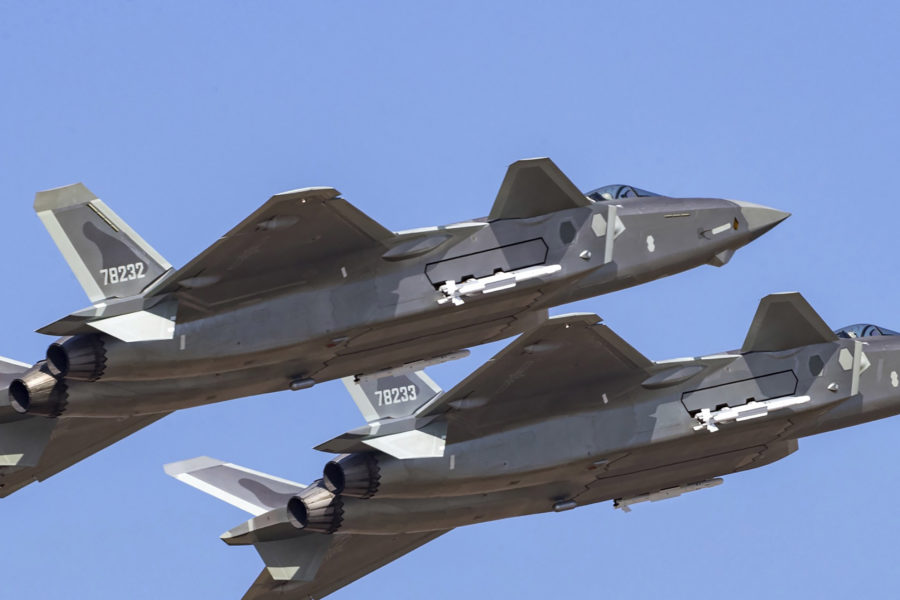The People’s Liberation Army Air Force is upgrading the Chengdu J-20 Mighty Dragon, China’s answer to the Lockheed Martin F-22, and is experimenting with manned-unmanned teaming concepts, much in the same way the U.S. Air Force is doing, according to the Pentagon’s latest assessment of Chinese military power.
In the annual China Military Power Report, released in mid-October, the Pentagon reports that the PLAAF “is preparing upgrades for the J-20, which may include increasing the number of air-to-air missiles (AAM) the fighter can carry in its low-observable configuration, installing thrust-vectoring engine nozzles, and adding super cruise capability by installing higher-thrust indigenous WS-15 engines.”
The two-seat J-20S has also been introduced, and experts speculate that this version is being evaluated for possible control of autonomous escort aircraft.
Since the J-20 already has the capacity to launch a number of missiles equivalent to the F-22, the carriage upgrade in stealth mode would give the J-20 a distinctive edge over the F-22; particularly because the J-20 can carry the PL-15, which is China’s counterpart to the U.S. AIM-120 Advanced Medium Range Air-to-Air Missile. While the range of the PL-15 is speculative and the range of the latest version of AMRAAM is classified, senior USAF officials have said the PL-15’s range exceeds that of the AMRAAM, giving the Chinese stealth fighter a potential first-look/first-shot capability against the American fighter.
The Air Force has been developing the AIM-260 Joint Advanced Tactical Missile (JATM), built by Lockheed Martin, since about 2017, but the program is highly classified. When it was first revealed at an industry conference in 2019, Air Force munitions leaders said the weapon would be operational in 2022, but no announcement has been made indicating that has happened, and the Air Force has declined to answer any questions about the missile since.
While the report didn’t indicate how many J-20s China has built, industry experts have said that by early 2023, Chengdu had manufactured between 180-220 J-20s, eclipsing the 187 F-22s built by the U.S. They also report that China is building J-20s at a rate of 40-50 per year. However, those analyses are based on serial markings seen on aircraft at air and trade shows, and China may have painted deceptive serial markings on its aircraft to suggest a greater inventory than it actually has on hand.
Most J-20s are deployed in the interior of China or near the Indian border, making it hard for Western analysts without access to national satellite imagery to make a reliable count.
The China report kept largely mum about the PLAAF and People’s Liberation Army Navy (PLAN)’s counterpart to the F-35, known in China as the FC-31/J-31.
“Development continues on the smaller FC-31/J-31 for export or as a future naval fighter for the PLAN’s next class of aircraft carriers,” the report said, without commenting on the jet’s progress.
Early versions of the J-31 seemed to be near-clones of the F-35, but more recent imagery shows a more elongated overall shape, with larger tail surfaces, perhaps more suggestive of the F-22. Unlike the F-35, the J-31 has two engines.
The report indicated that roughly 1,300 of China’s 1,900 fighters are fourth-generation or better. The J-20 and FC-31/J-31 are considered fifth-generation types.
The Pentagon’s assessment offered little new information on China’s H-20 stealth bomber program, reportedly a near-twin of the U.S. Air Force’s B-2 bomber, except to say that Chinese state media has reported “that this new stealth bomber will have a nuclear mission in addition to filling conventional roles.”
China is upgrading its existing H-6 Badgers, based on 1950s-era Tu-16 bombers built under license from Russia. The H-6 serves in both the PLAAF and PLAN, and these aircraft have in recent years been equipped with long-range, standoff land-attack missiles, “giving the PLA a long-range standoff precision strike capability that can range targets in the Second Island Chain from home airfields in mainland China,” the Pentagon said.
The navalized H-6N can carry “an air-launched ballistic missile,” the report noted, which “may be nuclear capable.”
In addition to fielding more mature air combat capabilities, China is developing a host of unmanned air vehicles, ranging from handheld units to large aircraft in the class of the U.S.’s RQ-4 Global Hawk.
“Air and trade shows are displaying growing numbers of autonomous and teaming systems, including for combat applications,” the report said. “In these concepts, Chinese developers are demonstrating an interest in additional growth beyond [intelligence, surveillance and reconnaissance] and EW (electronic warfare) into both air-to-air and air-to-ground combat, with a substantial amount of development displaying efforts to produce swarming capability for operational applications.”
China has displayed large stealthy-looking, jet-powered drones in military parades, and has a number of drones in the class of the U.S. MQ-1 Predator and MQ-9 Reaper, which it is also making available for export, the report noted.
